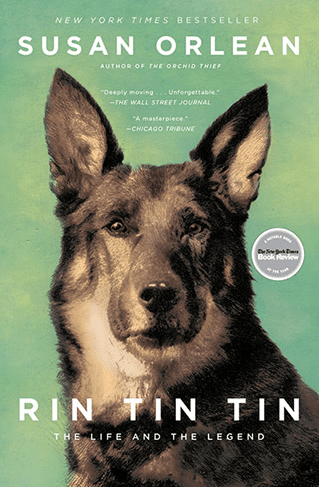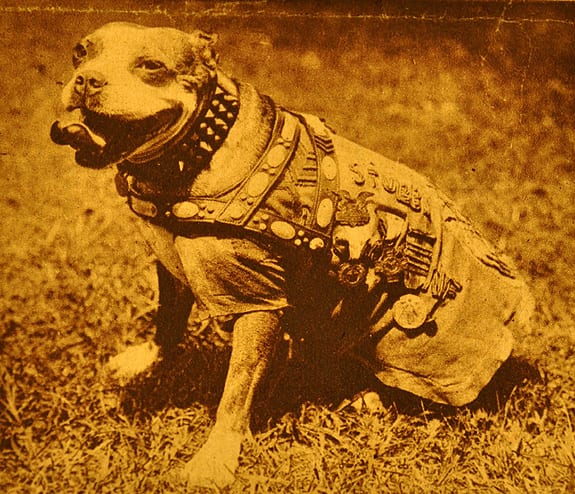 Dogs have played a variety of roles in their long history of domestication. During wars, dogs served along with many other animals. As cited in Susan Orlean’s book Rin Tin Tin, 16 million animals deployed in World War I: camels, cavalry and draft horses, homing pigeons, mules, oxen, and dogs.
Dogs have played a variety of roles in their long history of domestication. During wars, dogs served along with many other animals. As cited in Susan Orlean’s book Rin Tin Tin, 16 million animals deployed in World War I: camels, cavalry and draft horses, homing pigeons, mules, oxen, and dogs.
Dogs pulled carts filled with ordnance and ammunition, guarded posts, cleared rodents from trenches and served as messengers and mercy dogs. After battles, they roamed among the fallen with medical supplies for the living and comfort for the dying. Cadaver dogs aided medics by surveying battlefields, scenting for life. The most popular dogs were terriers that carried saddlebags filled with cigarettes and circulated among the troops.
 Some WWI dogs became celebrities, such as Sergeant Stubby, a small stray pit bull and mascot of the 102nd Infantry in 1917. He comforted the wounded, warned against a poison gas attack and bit a German infiltrator before being wounded in action. After the war, Stubby traveled the U.S. and met three presidents. His stuffed body rests in the Smithsonian.
Some WWI dogs became celebrities, such as Sergeant Stubby, a small stray pit bull and mascot of the 102nd Infantry in 1917. He comforted the wounded, warned against a poison gas attack and bit a German infiltrator before being wounded in action. After the war, Stubby traveled the U.S. and met three presidents. His stuffed body rests in the Smithsonian.
Up until the past several decades, most dogs worked on farms. There wasn’t any formal training either in war or peace; dogs either figured out how to perform the task or were euthanized. As the twentieth century progressed and people increasingly left family farms to live in cities and suburbs, dogs became less economically valuable and more emotionally priceless. Perhaps the same could be said of children.
The transition in the perception of dogs occurred between the world wars during the golden age of film. Starring in silent movies and then talkies, dogs like Rin Tin Tin performed heroic deeds on cue. Rin Tin Tin’s owner Lee Duncan used praise and play – a squeak toy – in order to train his dog to do stunts and poses. In Europe and the United States, Kennel Clubs added obedience competition to dog shows.
 After WWII, the dog population in the United States grew faster than humans. People’s relationship with dogs continued to change, as reflected in TV shows like Rin Tin Tin and Lassie. Dogs no longer lived outside in sheds; they became family members. Bred for work, dogs needed something to do to prevent boredom, which can cause a dog to become anxious or destructive. Play training by ordinary owners became fashionable.
After WWII, the dog population in the United States grew faster than humans. People’s relationship with dogs continued to change, as reflected in TV shows like Rin Tin Tin and Lassie. Dogs no longer lived outside in sheds; they became family members. Bred for work, dogs needed something to do to prevent boredom, which can cause a dog to become anxious or destructive. Play training by ordinary owners became fashionable.
Dogs’ working relationship with humans remained. Their roles in law enforcement and as Military Working Dogs (MWD) became more sophisticated, according to Maria Goodavage, author of Solider Dogs. Today, dogs sniff out all kinds of things – illnesses, insects (pests), cell phones, gas leaks, drugs, IEDs and more. Police and Military Working Dogs specialize in security, detection or attack. Training is intense – see the Schutzhund Club, run by a member of my writing group.
Farm hands, law enforcers, movie stars and companions, dogs provide loyal service to humans because dogs love the roles they play. For them, work is play.



We are a dog-loving writing group! Thank you for highlighting these wonderful creatures, Carole.
Perhaps our love of dogs makes us a better pack, I mean writing group:-)